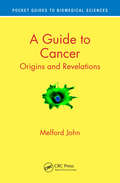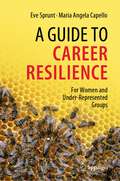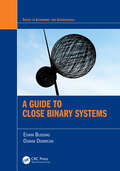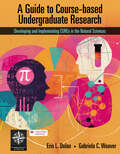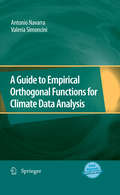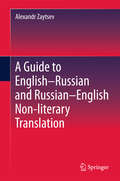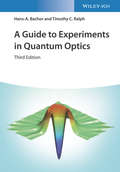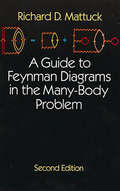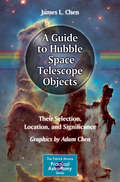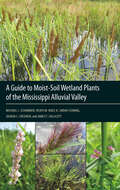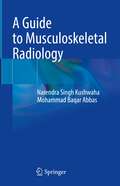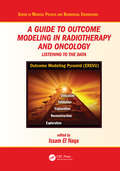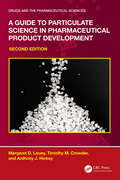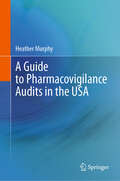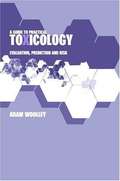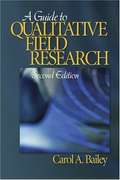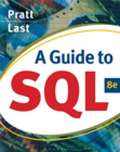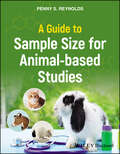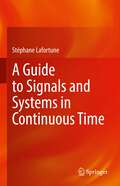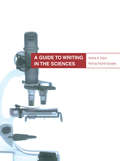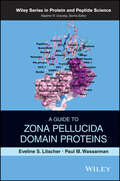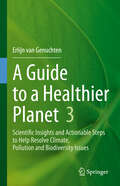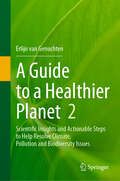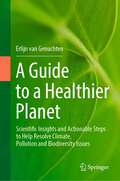- Table View
- List View
A Guide to Cancer: Origins and Revelations (Pocket Guides to Biomedical Sciences)
by Melford JohnA Guide to Cancer: Origins and Revelations unfolds the complex and fascinating topic of cancer in two ways: firstly, no specialist knowledge is assumed on the part of the reader, and secondly, despite the serious nature of the topics, the book aims to stimulate interest, provoke thought, and paradoxically entertain. It takes an array of complex topics and breaks them down in clear, concise terms, so that anyone with a basic knowledge of science can understand. The book is aimed at the general public as well as students of biological subjects, first and second year university students, and researchers in the nascent field of cancer genomics.
A Guide to Career Resilience: For Women and Under-Represented Groups
by Maria Angela Capello Eve SpruntMentors and sponsors are essential to career success, but these close relationships are not always free from trouble. This book shares advice and practical examples on how to survive and thrive throughout your career by differentiating between good and bad guidance you receive from mentors and sponsors. Real-life guidance is provided on how to manage troubled mentoring and sponsoring relationships at work.
A Guide to Close Binary Systems (ISSN)
by Edwin Budding Osman DemircanIntroduction to Close Binary Systems provides a comprehensive survey and guide to the fast-moving field of multiple, specifically binary, stars, with an up to date account of research around 'close', i.e. interacting pairs. Such interactions allow direct quantification of stellar properties, opening up factual insights into basic building blocks of the Universe.The book provides a much needed update for the seminal Close Binary Systems of Zdenĕk Kopal. Following a comparable plan, it presents relevant subject matter with an emphasis on building a framework of understanding to serve as a supporting resource for students and researchers. The text starts from a general historical background and progresses into the main theoretical ideas supporting our prima facie interpretation of observations. The central chapters explore further into these observational methods, arranged according to the classic subdivisions of astrometry, spectroscopy and photometry. Optimal inversion of observational data into model parametrization is a theme through these chapters. Significant here is the problem of how non-uniqueness in modelling affects interpretation. The underlying issues of stellar evolution bearing on observational evidence become paramount in the last four chapters. The book proceeds step-by-step from directly understandable examples of unevolved pairs to the challenging cases where stars are found in more and more extreme conditions, leading up to the mergers of massive black hole pairs seen in the new field of gravitational wave astronomy. This is a valuable reference for postgraduate and advanced undergraduate students working in mainstream areas of stellar astrophysics, with applications also to exoplanet research which shares some methodological features. Course designers for stellar astrophysics will find a useful selection of topics within this book.Key features:• Provides a well-explained and backgrounded, up-to-date account of close binary systems, in a fast-moving field of research that is growing in scientific importance• Surveys a wide range of case-studies within the context of binary and multiple star systems• Fills an acknowledged gap in current literatureCover Image: A public memorial to Zdenek Kopal in his home town (birthplace) of Litomysl in Czechia.
A Guide to Course-Based Undergraduate Research
by Erin Dolan Gabriela WeaverCourse-based Undergraduate Research Experiences (CUREs) are being championed by high profile organizations (American Association for the Advancement of Science, 2011; Olson & Riordan, 2012) for their potential to engage undergraduates in research at scale. CUREs are learning experiences in which whole classes of students address a research question or problem with unknown outcomes or solutions that are of interest to the scientific community. A growing body of evidence demonstrates the benefits of CUREs for student learning, development, and persistence in the natural sciences (Corwin, Graham, & Dolan, 2015; Gentile, Brenner, & Stephens, 2017; National Academies of Sciences, Engineering, and Medicine, 2015; Rodenbusch, Hernandez, Simmons, & Dolan, 2016). This guide will walk you through designing and implementing an Undergraduate Research Experience.
A Guide to Empirical Orthogonal Functions for Climate Data Analysis
by Valeria Simoncini Antonio NavarraClimatology and meteorology have basically been a descriptive science until it became possible to use numerical models, but it is crucial to the success of the strategy that the model must be a good representation of the real climate system of the Earth. Models are required to reproduce not only the mean properties of climate, but also its variability and the strong spatial relations between climate variability in geographically diverse regions. Quantitative techniques were developed to explore the climate variability and its relations between different geographical locations. Methods were borrowed from descriptive statistics, where they were developed to analyze variance of related observations-variable pairs, or to identify unknown relations between variables. A Guide to Empirical Orthogonal Functions for Climate Data Analysis uses a different approach, trying to introduce the reader to a practical application of the methods, including data sets from climate simulations and MATLAB codes for the algorithms. All pictures and examples used in the book may be reproduced by using the data sets and the routines available in the book . Though the main thrust of the book is for climatological examples, the treatment is sufficiently general that the discussion is also useful for students and practitioners in other fields. Supplementary datasets are available via http://extra.springer.com
A Guide to English-Russian and Russian-English Non-literary Translation
by Alexandr ZaytsevLying at the intersection of translatology, cognitive science and linguistics, this brief provides a comprehensive framework for studying, investigating and teaching English-Russian/Russian-English non-literary translation. It provides a holistic perspective on the process of non-literary translation, illustrating each of its steps with carefully analyzed real-life examples. Readers will learn how to choose and process multidimensional attention units in original texts by activating different types of knowledge, as well as how to effectively devise target-language matches for them using various translation techniques. It is rounded out with handy and feasible recommendations on the structure and content of an undergraduate course in translation. The abundance of examples makes it suitable not only for use in the classroom, but also for independent study.
A Guide to Experiments in Quantum Optics
by Hans-A. Bachor Timothy C. RalphProvides fully updated coverage of new experiments in quantum optics This fully revised and expanded edition of a well-established textbook on experiments on quantum optics covers new concepts, results, procedures, and developments in state-of-the-art experiments. It starts with the basic building blocks and ideas of quantum optics, then moves on to detailed procedures and new techniques for each experiment. Focusing on metrology, communications, and quantum logic, this new edition also places more emphasis on single photon technology and hybrid detection. In addition, it offers end-of-chapter summaries and full problem sets throughout. Beginning with an introduction to the subject, A Guide to Experiments in Quantum Optics, 3rd Edition presents readers with chapters on classical models of light, photons, quantum models of light, as well as basic optical components. It goes on to give readers full coverage of lasers and amplifiers, and examines numerous photodetection techniques being used today. Other chapters examine quantum noise, squeezing experiments, the application of squeezed light, and fundamental tests of quantum mechanics. The book finishes with a section on quantum information before summarizing of the contents and offering an outlook on the future of the field. -Provides all new updates to the field of quantum optics, covering the building blocks, models and concepts, latest results, detailed procedures, and modern experiments -Places emphasis on three major goals: metrology, communications, and quantum logic -Presents fundamental tests of quantum mechanics (Schrodinger Kitten, multimode entanglement, photon systems as quantum emulators), and introduces the density function -Includes new trends and technologies in quantum optics and photodetection, new results in sensing and metrology, and more coverage of quantum gates and logic, cluster states, waveguides for multimodes, discord and other quantum measures, and quantum control -Offers end of chapter summaries and problem sets as new features A Guide to Experiments in Quantum Optics, 3rd Edition is an ideal book for professionals, and graduate and upper level students in physics and engineering science.
A Guide to Feynman Diagrams in the Many-Body Problem: Second Edition
by Richard D. Mattuck"A great delight to read." -- Physics TodayAmong the most fertile areas of modern physics, many-body theory has produced a wealth of fundamental results in all areas of the discipline. Unfortunately the subject is notoriously difficult and, until the publication of this book, most treatments of the topic were inaccessible to the average experimenter or non-specialist theoretician.The present work, by contrast, is well within the grasp of the nonexpert. It is intended primarily as a "self-study" book that introduces one aspect of many-body theory, i.e. the method of Feynman diagrams. The book also lends itself to use as a reference in courses on solid state and nuclear physics which make some use of the many-body techniques. And, finally, it can be used as a supplementary reference in a many-body course.Chapters 1 through 6 provide an introduction to the major concepts of the field, among them Feynman diagrams, quasi-particles and vacuum amplitudes. Chapters 7 through 16 give basic coverage to topics ranging from Dyson's equation and the ladder approximation to Fermi systems at finite temperature and superconductivity. Appendixes summarize the Dirac formalism and include a rigorous derivation of the rules for diagrams. Problems are provided at the end of each chapter and solutions are given at the back of the book.For this second edition, Dr. Mattuck, formerly of the H. C. Orsted Institute and the University of Copenhagen, added to many chapters a new section showing in mathematical detail how typical many-body calculations with Feynman diagrams are carried out. In addition, new exercises were included, some of which gave the reader the opportunity to carry out simpler many-body calculations himself. new chapter on the quantum field theory of phase transitions rounds out this unusually clear, helpful and informative guide to the physics of the many-body problem.
A Guide to Hubble Space Telescope Objects: Their Selection, Location, and Significance (The Patrick Moore Practical Astronomy Series)
by James L. Chen Adam ChenFrom the authors of "How to Find the Apollo Landing Sites," this is a guide to connecting the view above with the history of recent scientific discoveries from the Hubble Space Telescope. Each selected HST photo is shown with a sky map and a photograph or drawing to illustrate where to find it and how it should appear from a backyard telescope. Here is the casual observer's chance to locate the deep space objects visually, and appreciate the historic Hubble photos in comparison to what is visible from a backyard telescope. HST objects of all types are addressed, from Messier objects, Caldwell objects, and NGC objects, and are arranged in terms of what can be seen during the seasons. Additionally, the reader is given an historical perspective on the work of Edwin Hubble, while locating and viewing the deep space objects that changed astronomy forever. Countless people have seen the amazing photographs taken by the Hubble Space Telescope. But how many people can actually point out where in the sky those objects are? Why were these objects chosen to be studied? What discoveries were made from the Hubble Space Telescope photographs? This book is for anyone who wants answers to these questions.
A Guide to Managing Zoo Animal Welfare: A Behavioral Approach
by Jason V. Watters Bethany L. KrebsComprehensive reference detailing behavioral assessment techniques, behavioral approaches, and practical tools for animal welfare across different species A Guide to Managing Zoo Animal Welfare delivers a step-by-step guide to behavioral assessment approaches, techniques, and tools for animal welfare with an emphasis on animals living in zoos and aquaria. The authors develop a unique “balance-based” approach that can be used to assess and enhance the welfare of a diverse range of species. Backed by extensive scientific literature, this book also provides foundational context to help readers to understand why the authors give these recommendations and guidelines. This book is divided into three sections. Section I details background concepts and goals, discussing the animal mind through neuroscience, psychology, and behavior, even questioning wild animal behavior’s validity as a template for captive animal behavior. Section II details the core behavioral Needs of animals, investigating, acquiring rewards, and exerting control. Section III explains how to practically assess if animals’ Needs are met and address deficiencies, covering topics like food, space, and social rewards and methods to make environments dynamic. A Guide to Managing Zoo Animal Welfare includes information on: Proximate and ultimate reasoning for the existence of each of the NeedsWelfare benefits of meeting the Needs, including positive affect, maintaining homeostasis, passing on genes, and learning through reinforcementThe highly variable personalities of individual animals and different animal species, as well as why personality is an important facet of animal welfareA guide for assessing animal welfare using the Three Needs model Presenting highly unique insight and a novel approach, A Guide to Managing Zoo Animal Welfare is an essential learning resource for professional animal behaviorists in zoos and aquaria, researchers in animal behavior and animal welfare, and students in veterinary sciences and zoology programs of study.
A Guide to Moist-Soil Wetland Plants of the Mississippi Alluvial Valley
by Michael L. Schummer Heath M. Hagy K. Sarah Fleming Joshua C. Cheshier James T. CallicuttMoist-soil wetlands are seasonally flooded areas that produce early-succession plant communities of grasses, sedges, and other herbaceous plants. Moist-soil wetland plants provide food and cover for a diversity of wildlife species, including waterfowl and other waterbirds. Thus, conservation and management of moist-soil plants has become a major component of wildlife conservation efforts in the Mississippi Alluvial Valley and elsewhere in North America. The authors combined their extensive experience working in managed and unmanaged wetlands from southern Missouri to southern Louisiana to produce this beautifully illustrated identification guide. A detailed, yet user friendly field guide to identify moist-soil plants of the Mississippi Alluvial Valley has not been available until now. Management to encourage the growth of moist-soil plants is a common conservation strategy used by state, federal, and private landowners to increase food and cover for wildlife. Thus, landowners must be able to identify moist-soil plants to meet their wildlife conservation goals. Landowners, scientists, wildlife biologists, and students alike will welcome this useful resource which includes 600 detailed color photographs of plants, images of seeds and tubers, and other helpful information to aid in identification. The book includes subsections of major plant groups occurring in moist-soil wetlands including aquatics, grasses, broadleaves, sedges and rushes, trees and shrubs, vines, and agricultural crops.
A Guide to Musculoskeletal Radiology
by Narendra Singh Kushwaha Mohammad Baqar AbbasThis book covers all the aspects of orthopedic skeletal radiographic imaging or musculoskeletal radiology. It fills the gap and simply presents essential concepts. It emphasizes radiology principles as well as important surgical aspects. It assists readers in understanding the fundamentals of a radiograph and its interpretation. It includes a description of radiographs helpful for students and surgeons. The book is suitable for practicing orthopedic surgeons, radiologists and postgraduate students of orthopedic surgery, FNB students during their specialization fellowship.
A Guide to Outcome Modeling In Radiotherapy and Oncology: Listening to the Data (Series in Medical Physics and Biomedical Engineering)
by Issam El NaqaThis book explores outcome modeling in cancer from a data-centric perspective to enable a better understanding of complex treatment response, to guide the design of advanced clinical trials, and to aid personalized patient care and improve their quality of life. It contains coverage of the relevant data sources available for model construction (panomics), ranging from clinical or preclinical resources to basic patient and treatment characteristics, medical imaging (radiomics), and molecular biological markers such as those involved in genomics, proteomics and metabolomics. It also includes discussions on the varying methodologies for predictive model building with analytical and data-driven approaches. This book is primarily intended to act as a tutorial for newcomers to the field of outcome modeling, as it includes in-depth how-to recipes on modeling artistry while providing sufficient instruction on how such models can approximate the physical and biological realities of clinical treatment. The book will also be of value to seasoned practitioners as a reference on the varying aspects of outcome modeling and their current applications. Features: Covers top-down approaches applying statistical, machine learning, and big data analytics and bottom-up approaches using first principles and multi-scale techniques, including numerical simulations based on Monte Carlo and automata techniques Provides an overview of the available software tools and resources for outcome model development and evaluation, and includes hands-on detailed examples throughout Presents a diverse selection of the common applications of outcome modeling in a wide variety of areas: treatment planning in radiotherapy, chemotherapy and immunotherapy, utility-based and biomarker applications, particle therapy modeling, oncological surgery, and the design of adaptive and SMART clinical trials
A Guide to Particulate Science in Pharmaceutical Product Development (Drugs and the Pharmaceutical Sciences)
by Anthony J. Hickey Margaret D. Louey Timothy M. CrowderThe pharmaceutical applications of powder technology have long been recognized. Yet while many books focus on aspects of powder formation and behavior, there are few texts that explore the power of particulate science in the design, manufacture, and control of quality medicines. This revision discusses key principles and practical applications. The authors cover particulate material, its form and production, sampling from bodies of powder, particle size descriptors and statistics, behavior of particles and powder, instrumental analysis, particle size measurement and synergy of adopted techniques, and in vitro and in vivo performance criteria. Case studies are included in this new edition.This fully revised edition: Provides an essential account of particulate science including several new chapters on multicomponent particles, regulatory considerations and product development Presents a variety of topics ranging from the quality of published data on particle size in pharmaceuticals to the future of crystal engineering Reviews methods of particle measurement and their importance for specific applications Discusses misconceptions and misunderstandings of particulate science together with lessons from other industries
A Guide to Pharmacovigilance Audits in the USA
by Heather MurphyPharmacovigilance Audits are an important and growing requirement for Pharmaceutical/BioTech companies. A niche skillset combined with an understanding of audit principles and pharmacovigilance operational and regulatory knowledge are required to effectively conduct these audits This book provides practical guidance to auditors as to what questions to ask, what information to look for, and what documents to request to ensure the auditee Pharmacovigilance System is compliant with regulations, contractual requirements, and industry best practice. The scope is limited to the requirements based on the US Food and Drug Administration (FDA) Regulations. This is an ideal book for auditors and auditees who want to obtain practical PV auditing skills to use within the BioTechnology/Pharmaceutical Industry in the USA.
A Guide to Practical Toxicology: Evaluation, Prediction and Risk
by Adam WoolleyAn experienced toxicologist researcher and consultant provides an overview of toxicology for practicing toxicologists and students in the field, with 15 chapters addressing topics from the necessity of measurement and definitions and maintenance of normality to larger issues of risk assessment and management in the workplace and environment and the future of toxicity testing. Pedagogical tools include text boxes with necessary background information; tables and case studies; and study design and interpretation. Annotation ©2004 Book News, Inc., Portland, OR (booknews.com)
A Guide to Qualitative Field Research
by Carol A. BaileyThoroughly revised, the Second Edition of A Guide to Qualitative Field Research provides novice researchers with comprehensive and accessible instructions for conducting qualitative field research. Using rich examples from classic ethnographies to help bring abstract principles alive, author Carol A. Bailey thoroughly explains the entire research process from selecting a topic to writing the final manuscript, and all of the steps in between!
A Guide to SQL (Eighth Edition)
by Mary Z. Last Philip J. PrattA GUIDE TO SQL, 8E, continues to be the essential SQL reference. It builds on the success of previous editions by presenting basic SQL commands in the context of a running case in which a business uses SQL to manage orders, parts, customers, and sales reps. The book covers the fundamentals of SQL programming using straightforward instruction and extensive hands-on exercises. Continuing with its focus on learning the basics regardless of the database environment chosen, this edition features examples from the latest databases: Oracle 11g, Access 2007, and MySQL. The eighth edition expands on the use of running case studies by adding a third running case to the extensive hands-on pedagogy at the end of every chapter.
A Guide to Sample Size for Animal-based Studies
by Penny S. ReynoldsA Guide to Sample Size for Animal-based Studies Understand a foundational area of experimental design with this innovative reference Animal-based research is an essential part of basic and preclinical research, but poses a unique set of experimental design challenges. The most important of these are the 3Rs − Replacement, Reduction and Refinement − the principles comprising the ethical framework for humane animal-based studies. However, many researchers have difficulty navigating the design trade-offs necessary to simultaneously minimize animal use, and produce scientific information that is both rigorous and reliable. A Guide to Sample Size for Animal-based Studies meets this need with a thorough, accessible reference work to the subject. This book provides a straightforward systematic approach to “rightsizing” animal-based experiments, with sample size estimates based on the fundamentals of statistical thinking: structured research questions, variation control and appropriate design of experiments. The result is a much-needed guide to planning animal-based experiments to ensure scientifically valid and reliable results. This book offers: Step-by-step guidance in diverse methods for approximating and refining sample size Detailed treatment of research topics specific to animal-based research, including pilot, feasibility and proof-of-concept studies Sample size approximation methods for different types of data − binary, continuous, ordinal, time to event − and different study types − description, comparison, nested designs, reference interval construction and dose-response studies Numerous worked examples, using real data from published papers, together with SAS and R code A Guide to Sample Size for Animal-based Studies is a must-have reference for preclinical and veterinary researchers, as well as ethical oversight committees and policymakers.
A Guide to Signals and Systems in Continuous Time
by Stéphane LafortuneThis textbook is a concise yet precise supplement to traditional books on Signals and Systems, focusing exclusively on the continuous-time case. Students can use this guide to review material, reinforce their understanding, and see how all the parts connect together in a uniform treatment focused on mathematical clarity. Readers learn the “what”, “why” and “how” about the ubiquitous Fourier and Laplace transforms encountered in the study of linear time-invariant systems in engineering: what are these transforms, why do we need them, and how do we use them? Readers will come away with an understanding of the gradual progression from time-domain analysis to frequency-domain and s-domain techniques for continuous-time linear time-invariant systems. This book reflects the author’s experience in teaching this material for over 25 years in sophomore- and junior-level required engineering courses and is ideal for undergraduate classes in electrical engineering.
A Guide to Writing in the Sciences
by Patricia Patchet-Golubev Andrea A. GilpinWhile teaching writing to undergraduate science students, Gilpin and Patchet-Golubev discovered that although many relatively sophisticated manuals for scientific writing exist, most are aimed at mainly professionals or specialists and are of little practical use to the majority of students. This introductory guide fills that large gap.Direct and friendly in tone the book provides clear and concise explanations of the basic elements of scientific writing required of students. The various genres are detailed -- in particular lab reports and research essays - as well as scientific articles, poster presentations, proposals, and even essay exams. Similarities and differences among these genres are underlined in order to illustrate structural principles and to provide practical writing tips. A detailed chapter covers the elements of grammar and punctuation that are fundamental to all good writing; it also outlines some key points about scientific style in particular.Using accessible language throughout, the authors organize their material with helpful lists, copious examples, and boxed writing and research tips. There are several useful appendices (including a classification chart of organisms and an international units conversion chart), an index, and selected bibliography on science and technical writing. Unique in its field, this guide offers a practical and valuable guide to the basic principles and conventions of science writing.
A Guide to Zona Pellucida Domain Proteins
by Eveline S. Litscher Paul M. WassarmanThis book provides a coherent, clear, and uniform presentation of structural, genetic, molecular, and biochemical information available for the zona pellucida domain protein family, which impact pathologies such as infertility, deafness, and cancer. Furthermore it: Details information about the structure and function of the ZP domain in ZPDC-proteins Provides illustrations of the organization of ZPDC-proteins, the genes that encode the proteins, and examples of mutations in the ZP domain that cause diseases Speculates as to the evolution of the ZP domain and potential therapeutics for diseases stemming from ZP domain mutations Addresses mammalian and non-mammalian systems
A Guide to a Healthier Planet 3: Scientific Insights and Actionable Steps to Help Resolve Climate, Pollution and Biodiversity Issues
by Erlijn van GenuchtenThis successor volume builds upon the previous books with additional chapters meant to inspire readers to take action towards a healthier planet. It focuses on closing the gap between scientific insights on pressing environmental issues that do not often reach the general public, and putting that scientific knowledge in the hands of everyday people who can use these insights to take action against climate change, pollution, and biodiversity loss. The goal of this work is to share fascinating facts about nature and sustainability to inspire taking action toward a healthier planet, and to provide ideas on how we can take action to solve environmental issues in an informed and easy-to-understand way. All chapters are based on open-access research articles covering various environmental issues and solutions that are not often disseminated in popular discourse but are nonetheless important for non-scientific audiences to understand and become familiar with. They allow readers to explore the broad range of concepts and issues and recognize the far-reaching consequences, and trigger the desire to take action. Also, each chapter provides concrete ideas of how we as individuals can take action in daily life to make a positive difference related to the issues described. The book is a multimodal work, as it includes images and videos that accompany the text.
A Guide to a Healthier Planet, Volume 2: Scientific Insights and Actionable Steps to Help Resolve Climate, Pollution and Biodiversity Issues
by Erlijn van GenuchtenThis successor volume builds upon the first book with additional chapters meant to inspire readers to take action towards a healthier planet. It focuses on closing the gap between scientific insights on pressing environmental issues that do not often reach the general public, and putting that scientific knowledge in the hands of everyday people who can use these insights to take action against climate change, pollution, and biodiversity loss. The goal of this work is to share fascinating facts about nature and sustainability to inspire taking action toward a healthier planet, and to provide ideas on how we can take action to solve environmental issues in an informed and easy-to-understand way. The chapters are sourced from the author's work published on medium.com/@ErlijnG with added content not available on medium.com.All chapters are based on open-access research articles covering various environmental issues and solutions that are not often disseminated in popular discourse but are nonetheless important for non-scientific audiences to understand and become familiar with. They allow readers to explore the broad range of concepts and issues and recognize the far-reaching consequences, and trigger the desire to take action. Also, each chapter provides concrete ideas of how we as individuals can take action in daily life to make a positive difference related to the issues described. The book is a multimodal work, as it includes images and videos that accompany the text.
A Guide to a Healthier Planet: Scientific Insights and Actionable Steps to Help Resolve Climate, Pollution and Biodiversity Issues
by Erlijn van GenuchtenThis book focuses on closing the gap between scientific insights on pressing environmental issues that do not often reach the general public, and putting that scientific knowledge in the hands of everyday people who can use these insights to take action against climate change, pollution, and biodiversity loss. The goal of this work is to share fascinating facts about nature and sustainability to inspire taking action toward a healthier planet, and to provide ideas on how we can take action to solve environmental issues in an informed and easy-to-understand way. The chapters are sourced from the author's work published on medium.com/@ErlijnG with added content not available on medium.com.All chapters are based on open-access research articles covering various environmental issues and solutions that are not often disseminated in popular discourse but are nonetheless important for non-scientific audiences to understand and become familiar with. They allow readers to explore the broad range of concepts and issues and recognize the far-reaching consequences, and trigger the desire to take action. Also, each chapter provides concrete ideas of how we as individuals can take action in daily life to make a positive difference related to the issues described. The book is a multimodal work, as it includes images and videos that accompany the text.
